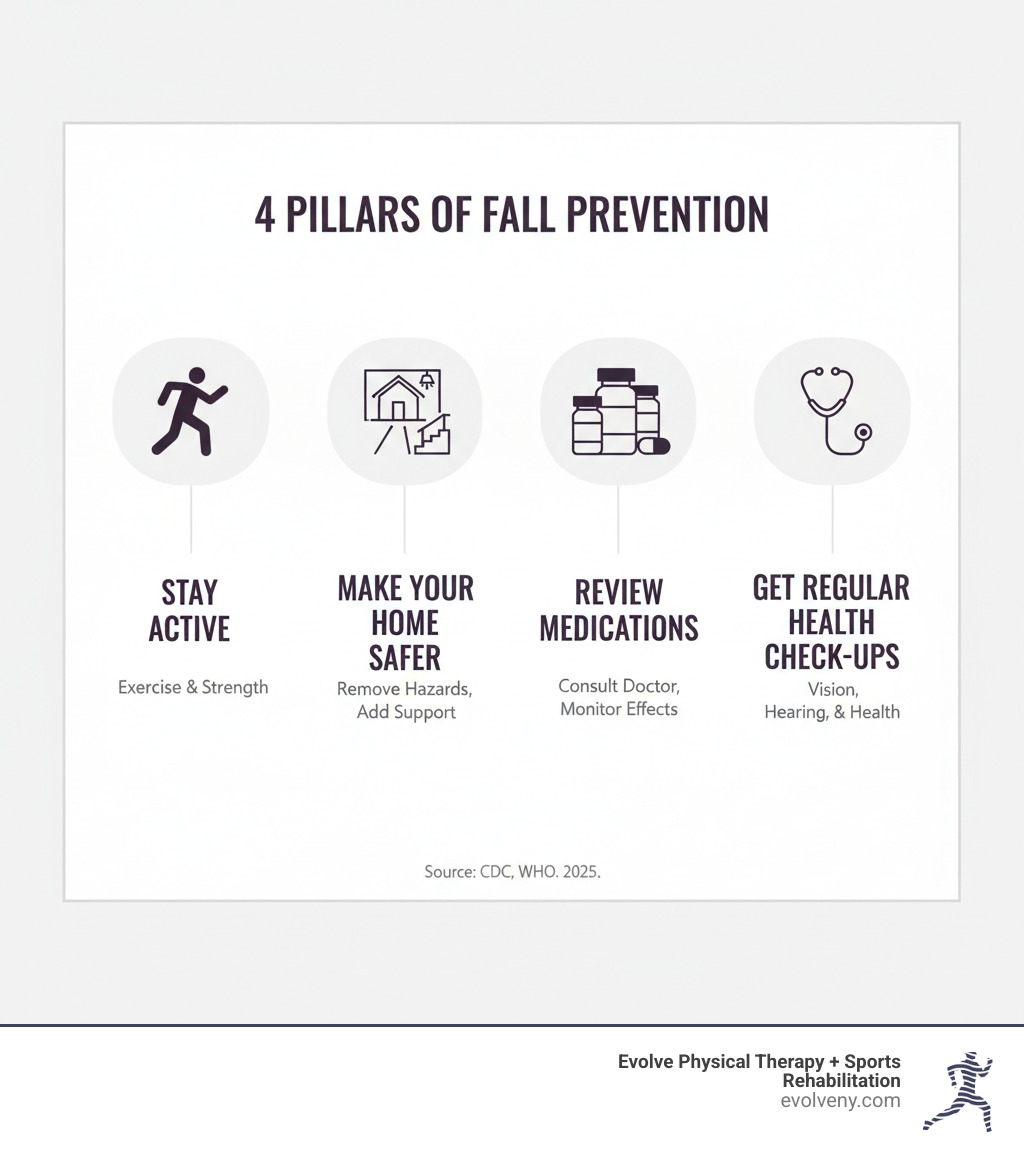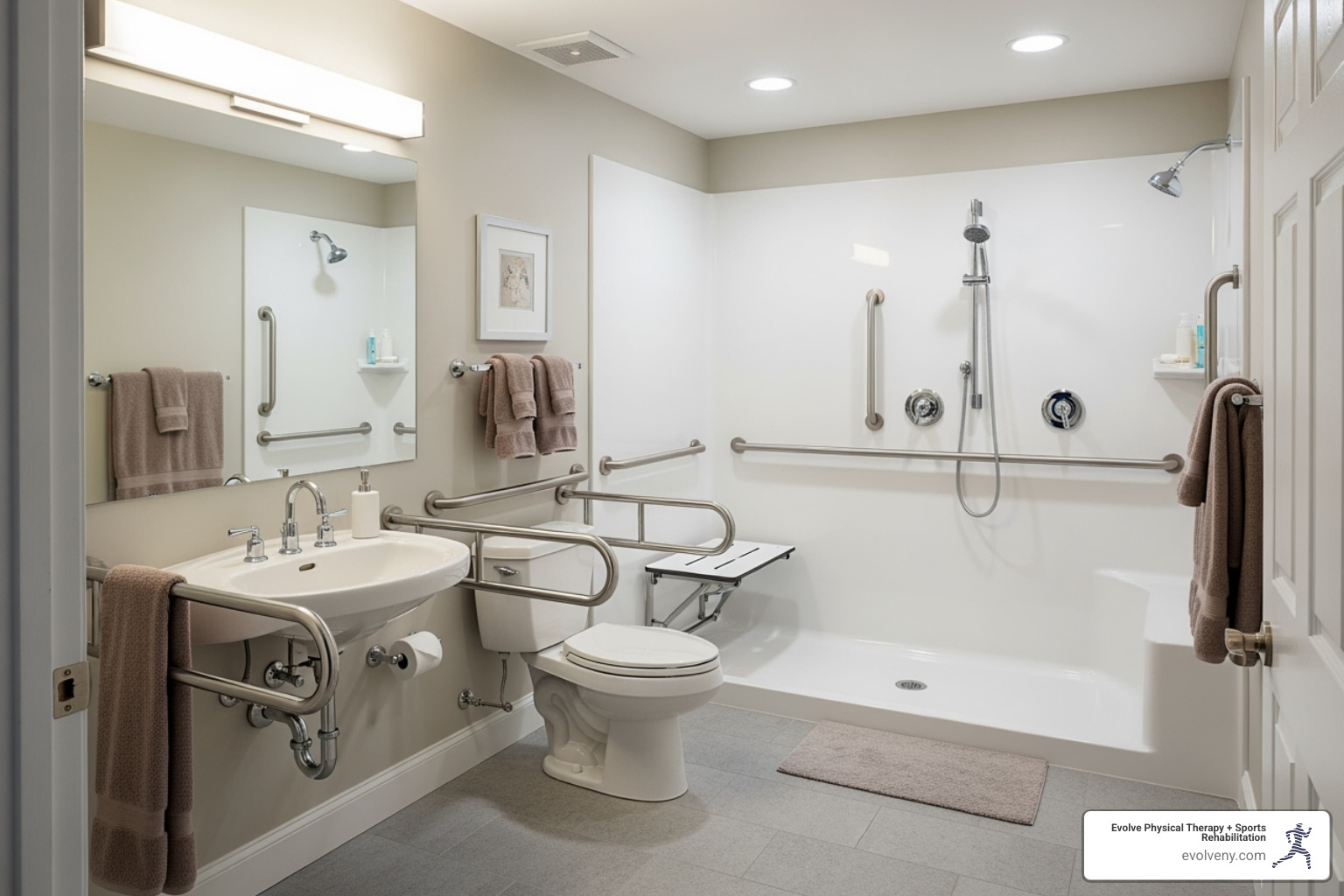Don't Trip Up: Proven Fall Prevention Tips for Older Adults
Why Fall Prevention Matters More Than You Think
Fall prevention strategies are essential for maintaining independence and quality of life as you age. Here are the most effective, research-backed approaches:
Core Fall Prevention Strategies:
- Stay Physically Active - Programs like Tai Chi can reduce falls by up to 35%.
- Make Your Home Safer - Remove tripping hazards, improve lighting, and install grab bars.
- Review Your Medications - Many drugs cause dizziness or drowsiness that increases fall risk.
- Get Regular Check-ups - Annual vision, hearing, and health assessments catch problems early.
- Wear Proper Footwear - Use non-skid, low-heeled, well-fitting shoes.
- Use Assistive Devices - Canes and walkers provide stability when needed.
The stakes are high. More than one in four adults over 65 fall each year, leading to over 38,000 deaths in 2021 and nearly 3 million emergency room visits. The annual medical costs are a staggering $50 billion.
The good news is that falls are not an inevitable part of aging. Research proves they are preventable. Most falls happen at home, but simple changes to your environment and exercises to improve strength and balance can dramatically reduce your risk. The Otago Exercise Program, for example, reduced falls by 35%.
As Lou Ezrick, founder of Evolve Physical Therapy, I've spent nearly two decades helping older adults with personalized movement therapy and strength training. My approach addresses the root causes of instability, not just the symptoms.

Understanding Your Fall Risk
Understanding your personal risk of falling is the first step toward prevention. Falls are the leading cause of injury death for adults 65 and older, and in Canada, they account for 85% of seniors' injury-related hospitalizations.
Falls typically result from a combination of factors.
Biological changes with age matter. Declining eyesight and hearing, muscle loss (sarcopenia), and chronic conditions like diabetes or heart disease can affect stability. Postural hypotension—lightheadedness when standing up—and cognitive changes also play a role.
Daily choices contribute to your risk. A sedentary lifestyle leads to weaker muscles and poorer balance. Rushing, even in familiar spaces, and consuming alcohol can impair your balance and judgment.
Your environment is a major factor. In fact, 50% of falls causing hospitalization happen at home. Common hazards include clutter, poor lighting, loose rugs, and wet surfaces.
Understanding these factors is your foundation for creating effective fall prevention strategies. To get a clearer picture of your personal risk, you can take the Falls Free Checkup.
How to Assess Your Personal Risk
Answering these questions can help you assess your risk.
- Have you fallen in the past year? A previous fall is a strong predictor of future falls, signaling underlying issues that need attention.
- Do you feel unsteady when walking or standing? This feeling often indicates balance issues that can be addressed.
- Are you taking medications that cause drowsiness or dizziness? Even over-the-counter drugs can have side effects that increase fall risk.
- Have you noticed changes in your vision or hearing? Difficulty seeing obstacles or hearing sounds can impact your safety.
- Do your feet hurt or feel numb? Foot problems and poor footwear are often connected to falls.
- Are there hazards in your home you regularly steer around?
If you answered yes to any of these, it's time for a conversation with your doctor or physical therapist. They can conduct assessments like gait analysis and balance testing to pinpoint concerns. Learn more about how we can help with physical therapy for balance disorders.
The Fear of Falling Cycle
The fear of falling is a common anxiety that can, ironically, increase your fall risk. This fear often leads to a vicious cycle:
- You become afraid of falling, so you move less.
- Moving less causes your muscles to weaken and your balance to decline.
- Weaker muscles and poorer balance increase your actual risk of falling.
- This increased risk makes you even more fearful, continuing the cycle.
This pattern can lead to social isolation and a loss of independence. But you can break this cycle. Building confidence through targeted exercises helps you trust your body again.
Physical therapy is particularly effective at interrupting this fear cycle. We create structured programs that gradually challenge your balance in a safe, supportive environment, helping you build strength and confidence step by step. The goal is to help you reclaim an active, independent life. Learn more about how we approach balance and gait training to help you move confidently again.
Proactive Fall Prevention Strategies: Strengthening Your Body

Your body is your best defense against falls. Physical activity is one of the most powerful fall prevention strategies, with research showing the right exercise program can reduce fall risk by up to 35%.
At Evolve Physical Therapy, we specialize in preventing injuries before they happen. Our approach addresses the root causes of instability, from muscle weakness to risky movement patterns. Learn more about our comprehensive approach to physical therapy for fall prevention.
Recommended Exercises for Balance and Strength
Certain exercises are proven to reduce fall risk.
- Tai Chi: This gentle practice of slow, flowing movements improves balance, coordination, and flexibility. It's a low-impact option suitable for various fitness levels.
- The Otago Exercise Program: Delivered by physical therapists, this personalized, home-based program focuses on leg strengthening and balance retraining, reducing falls by 35% in studies.
- Walking: Regular walking builds leg strength and endurance. Aim for at least 150 minutes per week.
- Water Aerobics: The water supports your body while providing resistance, making it ideal for those with joint pain.
- Strength Training: Using resistance bands or light weights twice a week directly addresses muscle weakness in the legs, core, and upper body.
- Yoga and Pilates: These practices emphasize core strength, flexibility, and body awareness, which are all critical for balance.
The key is finding an activity you enjoy. Start slowly and gradually increase the intensity. For exercises you can do at home, see our guide to balance exercises at home. For more specialized guidance, explore our resources on balance training for seniors.
How Physical Therapy Creates a Custom Plan
Because every person is unique, effective fall prevention requires a custom plan. At Evolve Physical Therapy, our comprehensive assessment identifies the specific causes of your instability.
- Gait analysis reveals patterns in your walk that might increase fall risk.
- Strength assessment tests key muscle groups for stability, such as your legs, hips, and core. We have proven strategies to help you rebuild strength, as explained in our guide on physical therapy for muscle weakness.
- Balance testing shows how you maintain stability in different situations, helping us design targeted exercises.
Based on this data, we create a personalized exercise prescription. We teach you proper, safe form and gradually increase the difficulty as you get stronger. We also specialize in helping people overcome general deconditioning after illness or inactivity. Learn more about our approach to physical therapy for general deconditioning.
Our goal is to give you the physical capabilities and confidence to live an active, independent life.
Creating a Safer Environment at Home and Beyond

Surprisingly, 50% of falls causing hospitalization happen at home. The good news is that thoughtful changes can make your home much safer. Effective fall prevention strategies must include your environment. Most home modifications are simple and can make a dramatic difference.
Key Fall Prevention Strategies for Your Home
- Remove hazards: Clear clutter, cords, and other tripping hazards from floors and stairs.
- Secure rugs: Use double-sided tape or non-slip backing on all throw rugs, or remove them.
- Improve lighting: Install night lights in bedrooms, bathrooms, and hallways. Keep a lamp by your bed.
- Make bathrooms safer: Install grab bars by the toilet and in the shower. Use non-slip mats in the tub or shower and consider a bath seat.
- Secure stairs: Ensure stairs have solid handrails on both sides, are well-lit, and are always clear of clutter.
- Organize for reach: Store frequently used items where you can easily reach them without stretching or climbing.
- Clean spills immediately: Wipe up any spills, especially in the kitchen, to prevent slippery surfaces.
Footwear and Assistive Devices
Proper footwear is a key fall prevention strategy. Wear sturdy, well-fitting shoes with non-skid rubber soles and low heels. Avoid walking in socks or slippers on stairs or slippery floors.
If your doctor or physical therapist recommends a cane or walker, use it. These tools help you maintain independence. Ensure the device is the correct height and has non-worn rubber tips. At Evolve, we can help you choose and properly use the right assistive device. For more information, see our complete guide to physical therapy for balance.
What to Do If You Fall
Knowing how to respond to a fall can prevent a serious injury.
- Stay calm and assess. Before moving, take a moment to check for injuries. If you feel pain (especially in your head, neck, or back) or suspect a fracture, do not move. Call for help.
- Get up safely (if uninjured). Roll onto your side, then push up to your hands and knees. Crawl to a sturdy piece of furniture. Place your hands on the furniture, slide one foot forward, and push yourself up to a sitting position before standing.
- Call for help when needed. If you are injured, can't get up, or are alone, call for help immediately. Consider a medical alert system and keep a phone within reach.
Always tell your doctor about any fall, even if you aren't hurt. A fall can signal a new medical problem or medication side effect that needs to be addressed.
The Medical Side of Fall Prevention
Your healthcare team is a powerful partner in preventing falls. Regular check-ups can spot potential problems early. At Evolve Physical Therapy, we believe the best fall prevention strategies come from collaboration between you, your doctors, and your physical therapist to create a comprehensive safety plan.
Medical Fall Prevention Strategies to Discuss with Your Doctor
As we age, our bodies process medicines differently, and some can increase fall risk by causing side effects like dizziness or drowsiness. Medications to be aware of include:
- Sedatives and anxiolytics
- Antidepressants
- Antihistamines (e.g., Benadryl)
- Blood pressure medications
- Opioid pain medications
- Muscle relaxants
- Diabetes medications
- Antipsychotics
Taking multiple medications (polypharmacy) can also increase the risk of side effects.
Bring a complete list of all prescriptions, over-the-counter drugs, vitamins, and supplements to every doctor's appointment. Ask your doctor or pharmacist to review this list specifically for fall risk. They may be able to adjust dosages or switch to safer alternatives. The CDC information on fall interventions offers more resources on this topic.
The Importance of Vision, Hearing, and Nutrition
Your senses and nutrition play a large role in stability.
- Vision: Get annual eye exams to check for conditions like glaucoma and cataracts. Ensure your glasses prescription is current.
- Hearing: Even mild hearing loss is linked to increased fall risk. Get regular hearing tests and use aids if recommended.
- Nutrition and Bone Health: Strong bones can prevent a fall from becoming a fracture. Talk to your doctor about osteoporosis screening. Ensure you get enough calcium and Vitamin D through diet or supplements.
- Lifestyle: Quit smoking and limit alcohol, as both can decrease bone mass and impair balance. Maintaining a healthy weight is also important for bone health.
Frequently Asked Questions about Fall Prevention
We often hear similar questions from our patients and their families about fall prevention strategies. Here are some of the most common ones, answered with the practical insights we've gained from years of helping older adults stay safe and active:
What is the single most effective fall prevention strategy?
There is no single "magic bullet." The most effective approach is a multifaceted strategy that combines several interventions: regular exercise to improve balance and strength, home safety modifications, medication management, and regular health check-ups. Programs like Tai Chi and the Otago Exercise Program show their greatest impact when part of a comprehensive plan.
Can falls be completely prevented?
While not all falls can be prevented, your risk can be dramatically reduced. Falls are not an inevitable part of aging. By implementing comprehensive fall prevention strategies, you can significantly lower both the likelihood of falling and the severity of potential injuries. The goal is to empower you to live with greater confidence and substantially reduced risk.
How often should I review my medications for fall risk?
You should have all your medications reviewed by your doctor or pharmacist at least once a year. You should also request a review any time a new medication is prescribed, a dosage changes, or if you experience new side effects like dizziness or unsteadiness. Open communication with your healthcare team is a powerful way to protect yourself. For more information, the CDC provides extensive resources that can help guide your conversations with healthcare providers.
Take the Next Step in Fall Prevention
We've journeyed through quite a bit together today—from understanding the sobering statistics about falls to exploring the many practical fall prevention strategies you can start using right now. If there's one message we hope resonates with you, it's this: prevention is truly an investment in your independence. It's about protecting the life you've built and ensuring you can continue doing the things you love, on your own terms.
Taking these proactive steps isn't just about avoiding injury. It's about empowerment. It's about reclaiming confidence in your body and your ability to move through the world safely. Whether you start by clearing the clutter from your hallways, signing up for a Tai Chi class, reviewing your medications with your doctor, or simply having an honest conversation about your concerns, each action matters. Every small change adds up to create a safer, more active life.
At Evolve Physical Therapy + Sports Rehabilitation, we've dedicated ourselves to helping older adults just like you build strength, improve balance, and most importantly, regain confidence. We know that falls aren't just a physical issue—they affect your peace of mind, your willingness to stay active, and your overall quality of life. That's why we take a hands-on approach, creating personalized programs that address your specific challenges and goals.
Our expert physical therapists don't believe in cookie-cutter solutions. We take the time to understand your unique situation, conduct thorough assessments, and develop a plan that works for you. From gait analysis to customized exercise prescriptions, we're with you every step of the way. And we're proud to say that our specialized approach has helped countless Brooklyn residents move with greater confidence and freedom.
You don't have to steer this alone. The fear of falling doesn't have to control your choices or limit your life. With the right support and a commitment to evidence-based fall prevention strategies, you can take control of your stability and accept the independence you deserve.
Ready to get started? Take control of your stability with our specialized senior physical therapy programs. We're here to guide you, support you, and celebrate every milestone along the way. Your journey to greater confidence and safety begins with that first step—and we'd be honored to take it with you.



